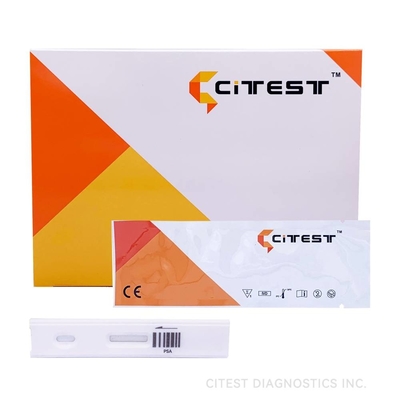

|
PERFORMANCE CHARACTERISTICS
1. Accuracy The deviation is ≤±15%. 2. Analytical sensitivity The PSA Test Cassette can detect levels of PSA as low as 2 ng/ml in serum, plasma. 3. Linearity range 2 – 100 ng/ml , R≥0.990 4. Precision C.V. ≤15% |
|
Prostate Specific Antigen (PSA) Diagnostic Test kit Use By CITEST GO fluorescence Immunoassay Analyzer In serum /plasma
| Product features | Parameters |
| Principle | Fluorescence Immunoassay |
| Format | Cassette |
| Specimen | S/P |
| Certificate | CE |
| Reading Time | 15 minutes |
| Pack | 10T/25T |
| Storage Temperature | 4-30°C |
| Shelf Life | 2 Years |
| Cut-Off | 4 ng/mL |
Application:
The Prostate Specific Antigen (PSA) Test Cassette (Serum/Plasma) is based on Fluorescence immunoassay for the quantitative detection of Prostate Specific Antigen in serum or plasma.
Description:
Prostate specific antigen (PSA) is produced by prostate glandular and endothelial cells. It is a single chain glycoprotein with a molecular weight of approximate 34 kDa.1 PSA exists in three major forms circulating in the serum. These forms are free PSA, PSA bound to α1 – Antichymotrypsin (PSA-ACT) and PSA complexed with α2–macroglobulin (PSA-MG).
PSA has been detected in various tissues of the male urogenital system but only prostate glandular and endothelial cells secrete it. The PSA level in serum of healthy men is between 0.1 ng/mL and 2.6 ng/mL. It can be elevated in malignant conditions such as prostate cancer, and in benign condition such as benign prostatic hyperplasia and prostatitis. A PSA level of 4 to 10ng/ml is considered to be in the “gray-zone” and levels above 10ng/ml are highly indicative of cancer. Patients with PSA values between 4-10ng/ml should undergo further analysis of the prostate by biopsy.
The prostate specific antigen test is the most valuable tool available for the diagnosis of early prostate cancer. Many studies have confirmed that the presence of PSA is the most useful and meaningful tumor marker known for prostate cancer and prostate infection of Benign Prostatic Hyperplasia (BPH).
How to use?
Refer to Citest TM Go Fluorescence Immunoassay Analyzer Operation Manual for the complete instructions on use of the Test. The test should be in room temperature.
Allow the test, specimen, buffer and/or controls to reach room temperature (15-30°C) prior to testing.
1. Turn on the Analyzer power. Then according to the need, select “Standard test” or “Quick test” mode.
2. Take out the ID card and insert it into the Analyzer ID Card Slot.
3. Pipette 20 μL of serum or plasma into the buffer tube, mix the specimen and the buffer well.
4. Pipette 75 μL diluted sample into the sample well of the cassette. Start the timer at the same time.
5. There are two test modes for Citest TM Go Fluorescence Immunoassay Analyzer, Standard Test mode and Quick Test mode.
Please refer to the user manual of Citest TM Go Fluorescence Immunoassay Analyzer for details.
“Quick test” mode: After 15 minutes of adding sample,Insert the test cassette into the Analyzer click “QUICK TEST”, fill the test information and click "NEW TEST" immediately. The Analyzer will automatically give the test result after a few seconds.
“Standard test” mode: Insert the test cassette into the Analyzer immediately after adding specimen, click “STANDARD TEST”, fill the test information and click "NEW TEST" at the same time. The Analyzer will automatically countdown 15 minutes. After the countdown, the Analyzer will give the result at once.
![]()
INTERPRETATION OF RESULTS
Results read by Citest TM Go Fluorescence Immunoassay Analyzer.
The result of tests for PSA is calculated by Citest TM Go Fluorescence Immunoassay Analyzer and will be displayed on the screen. For additional information, please refer to the user manual of FluroLit TM Fluorescence Immunoassay Analyzer.
Linearity range of Citest TM Go PSA is 2-100 ng/ml.
Reference range:< 4ng/ml.
| Catalogue Number | Item Name | Sample | Test Range | KIT size |
| FI-PSA-302 | PSA Test Cassette | S/P | 2~100 ng/mL | 10T/25T |